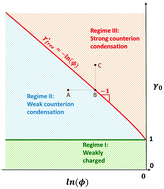Where in the world are condensed counterions?
Abstract
A scaling model of the concentration profiles of both condensed and free counterions is presented for solutions of spherical and cylindrical charged nanoparticles of different charge valences, nanoparticle sizes, and salt concentrations. The distribution of counterions for both spherical and cylindrical charged particles in salt-free solutions is determined by the condensation parameter γ0 defined as the ratio of nanoparticle valence Z0 to the number of Bjerrum lengths lB = e2/(εkT) per nanoparticle size (γ0 = Z0lB/(2r0) for spherical nanoparticles with radii r0 or γ0 = Z0lB/L for cylindrical particles with length L), where ε is solution dielectric permittivity, e is elementary charge and kT is thermal energy. Depending on the magnitudes of the condensation parameter γ0 and nanoparticle volume fraction ϕ, we find three qualitatively different regimes for the counterion distribution near charged particles: (i) weakly charged particles with no condensed counterions, (ii) regime of weak counterion condensation with less than half of the counterions condensed, and (iii) regime of strong counterion condensation with the majority of counterions condensed. The magnitude of electrostatic energy of a condensed counterion with respect to solution locations with zero electric field is larger than thermal energy kT, and the fraction of condensed counterions increases from less than half in the weak condensation regime to the majority of all counterions in the strong condensation regime. The condensed counterions are not bound to the nanoparticle surface but instead are localized within the condensed counterion zone near the charged particle. The thickness of the condensed counterion zone varies with the condensation parameter γ0, the nanoparticle shape and volume fraction ϕ, and the salt concentration and can be as narrow as Bjerrum length (∼nm) or as large as the particle size (∼L the length of charged cylinder).



 Please wait while we load your content...
Please wait while we load your content...
